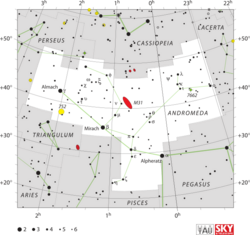Astronomy:3 Andromedae
| Observation data Equinox J2000.0]] (ICRS) | |
|---|---|
| Constellation | Andromeda |
| Right ascension | 23h 04m 10.98185s[1] |
| Declination | +50° 03′ 07.5297″[1] |
| Apparent magnitude (V) | 4.64[2] |
| Characteristics | |
| Evolutionary stage | giant[3] |
| Spectral type | K0 IIIb[4] |
| B−V color index | 1.058±0.003[2] |
| Astrometry | |
| Radial velocity (Rv) | −34.7±0.3[5] km/s |
| Proper motion (μ) | RA: 166.374[1] mas/yr Dec.: 167.463[1] mas/yr |
| Parallax (π) | 17.9785 ± 0.1522[1] mas |
| Distance | 181 ± 2 ly (55.6 ± 0.5 pc) |
| Absolute magnitude (MV) | 0.97[2] |
| Details | |
| Mass | 1.71[6] M☉ |
| Radius | 10[7] R☉ |
| Luminosity | 49[6] L☉ |
| Surface gravity (log g) | 2.61±0.11[8] cgs |
| Temperature | 4,668±45[6] K |
| Metallicity [Fe/H] | −0.08[3] dex |
| Rotational velocity (v sin i) | 1.0[9] km/s |
| Age | 2.27[6] Gyr |
| Other designations | |
| Database references | |
| SIMBAD | data |
3 Andromedae, abbreviated 3 And, is a single[11] star in the northern constellation of Andromeda. 3 Andromedae is the Flamsteed designation. It is visible to the naked eye with an apparent visual magnitude of 4.64.[2] The distance to this star, as determined from an annual parallax shift of 18 mas,[1] is 181 light years. It is moving closer to the Earth with a heliocentric radial velocity of −35 km/s,[5] and has a relatively large proper motion, traversing the celestial sphere at 0.236″·yr−1.[12]
This is an evolved giant star with a stellar classification of K0 IIIb,[4] where the 'b' suffix indicated a lower luminosity giant. It is a red clump star,[3] which means it is generating energy through helium fusion at its core. This star has an estimated 1.7[6] times the mass of the Sun (M☉), and, at the age of 2.3[6] billion years, has expanded to 10 times the Sun's radius (R☉).[7] It is radiating 49[6] times the Sun's luminosity from its enlarged photosphere at an effective temperature of 4,668 K.[6]
References
- ↑ 1.0 1.1 1.2 1.3 1.4 1.5 Brown, A. G. A. (August 2018). "Gaia Data Release 2: Summary of the contents and survey properties". Astronomy & Astrophysics 616: A1. doi:10.1051/0004-6361/201833051. Bibcode: 2018A&A...616A...1G.
- ↑ 2.0 2.1 2.2 2.3 Anderson, E.; Francis, Ch. (2012), "XHIP: An extended hipparcos compilation", Astronomy Letters 38 (5): 331, doi:10.1134/S1063773712050015, Bibcode: 2012AstL...38..331A.
- ↑ 3.0 3.1 3.2 Tautvaišienė, G. et al. (December 2010), "C, N and O abundances in red clump stars of the Milky Way", Monthly Notices of the Royal Astronomical Society 409 (3): 1213–1219, doi:10.1111/j.1365-2966.2010.17381.x, Bibcode: 2010MNRAS.409.1213T.
- ↑ 4.0 4.1 Keenan, Philip C.; McNeil, Raymond C. (1989), "The Perkins catalog of revised MK types for the cooler stars", Astrophysical Journal Supplement Series 71: 245, doi:10.1086/191373, Bibcode: 1989ApJS...71..245K.
- ↑ 5.0 5.1 Gontcharov, G. A. (2006), "Pulkovo Compilation of Radial Velocities for 35 495 Hipparcos stars in a common system", Astronomy Letters 32 (11): 759–771, doi:10.1134/S1063773706110065, Bibcode: 2006AstL...32..759G.
- ↑ 6.0 6.1 6.2 6.3 6.4 6.5 6.6 6.7 Luck, R. Earle (2015), "Abundances in the Local Region. I. G and K Giants", Astronomical Journal 150 (3): 88, doi:10.1088/0004-6256/150/3/88, Bibcode: 2015AJ....150...88L.
- ↑ 7.0 7.1 Massarotti, Alessandro et al. (January 2008), "Rotational and Radial Velocities for a Sample of 761 HIPPARCOS Giants and the Role of Binarity", The Astronomical Journal 135 (1): 209–231, doi:10.1088/0004-6256/135/1/209, Bibcode: 2008AJ....135..209M.
- ↑ Feuillet, Diane K. et al. (2016), "Determining Ages of APOGEE Giants with Known Distances", The Astrophysical Journal 817 (1): 40, doi:10.3847/0004-637X/817/1/40, Bibcode: 2016ApJ...817...40F.
- ↑ De Medeiros, J. R. et al. (November 2000), "Rotation and lithium in single giant stars", Astronomy and Astrophysics 363: 239–243, Bibcode: 2000A&A...363..239D.
- ↑ "3 And". SIMBAD. Centre de données astronomiques de Strasbourg. http://simbad.u-strasbg.fr/simbad/sim-basic?Ident=3+And.
- ↑ Eggleton, P. P.; Tokovinin, A. A. (September 2008), "A catalogue of multiplicity among bright stellar systems", Monthly Notices of the Royal Astronomical Society 389 (2): 869–879, doi:10.1111/j.1365-2966.2008.13596.x, Bibcode: 2008MNRAS.389..869E.
- ↑ Lépine, Sébastien; Shara, Michael M. (March 2005), "A Catalog of Northern Stars with Annual Proper Motions Larger than 0.15" (LSPM-NORTH Catalog)", The Astronomical Journal 129 (3): 1483–1522, doi:10.1086/427854, Bibcode: 2005AJ....129.1483L.
 |


